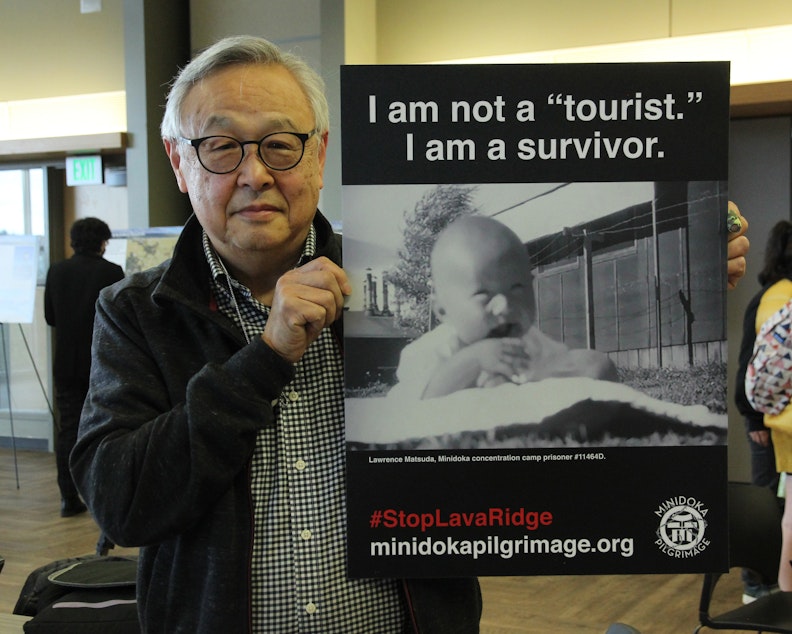'Sacred ground': Why Camp Minidoka's survivors say 'no' to this windfarm

Many Japanese Americans who were incarcerated during World War 2 at a federal camp in Minidoka, Idaho are opposing a wind farm project near the campsite. More than 13,000 people were imprisoned there, many were from the Seattle area.
The Bureau of Land Management is proposing a commercial-scale wind energy facility called the Lava Ridge Wind Project. The site would host up to 400 turbines on approximately 84,000 acres of federal, state, and private land. If approved the project would power as many as 300,000 homes.
The BLM published a draft of the environmental impact report this year. The agency has been collecting public comments for the project and, last week, concluded its in-person public comment tour on Mercer Island.
RELATED: Japanese Americans remember the legacy of 'camp' 80 years after their incarceration
About 40 people came to the event on Mercer Island, including activist Erin Shigaki. She is a fourth-generation Japanese American and many of her relatives were incarcerated at Minidoka. Shigaki also helps coordinate the “Minidoka Pilgrimage.” Every year survivors, descendants, and allies travel together from Seattle to visit Minidoka.
Shigaki says this project is “pitting us [people of color] against the need for clean energy.” She added, it also goes against promises made by the current administration.
Sponsored
“President Biden stated, when he came into office, that we were going to work toward a greener future. But, communities of color, we're not going to be left behind as they always have been," Shigaki said.
The environmental impact statement acknowledged that this project could cause “disproportionate high and adverse impacts to the Japanese American Community and Native American Tribes from changes to setting, feeling, and experience due to visual and noise impacts.”
The report also categorized survivors and descendants of the camp, who visit Minidoka as "tourists." When asked about the use of the word "tourists," representatives of the report's author, SWCA Environmental Consultants, called it a mischaracterization. They added that it was "offensive" and they are still learning how to use better language.
RELATED: New memorial honors Japanese Americans incarcerated at the Washington State Fairgrounds
Shigaki says it’s “inappropriate” to put a clean energy project near Minidoka because it's “sacred ground.” She says incarceration of Japanese Americans is a “huge scar” on our community. It's also a lesson that needs to be learned. Shigaki says information on what happened to her community is not widely published and in textbooks. Parts of the history is already being erased.
Sponsored
“I feel like this wind farm project is another piece of that erasure,” Shigaki said.
Lawrence Matsuda was born in Minidoka, Idaho, WRA camp, Block 26 Barrack #2. He also attended the public comment session and is opposed to the Lava Ridge project.
“You would never do that to the Washington Monument, to the Statue of Liberty," Matsuda said. "These windmills are not small, the Space Needle is 650 feet tall. So you're talking about putting 400 Space needles around a historic site.”
RELATED: WA will need more clean energy from other states by 2050
According to the BLM, “engineering is preliminary, but the turbines may have a maximum height (including the rotor) of up to 740 feet.”
Sponsored
In a letter to the BLM, Matsuda wrote, “the Lava Ridge proposal is nothing more than a brazen attempt of bait and switch to steal Minidoka’s identity.” He says Minidoka historic site would become “soulless” and “lost in the shadows Lava Ridge turning blades of profit…Lost, would be another tenuous fragment…of America that speaks to liberty and justice for all.”
Shigaki explained that descendants like herself and survivors like Matsuda return to Minidoka, the “sacred land,” to pay homage.
“These camps were all situated in these remote places. In the case of Minidoka, the high desert, very uninhabitable. I think that is the integral to the experience that people need to have to understand the lengths that the government went to hide us away,” Shigaki said, noting that the landscape is crucial. “There is great beauty there. When I’m walking on that ground, I think about what my grandparents were seeing to sustain themselves; the birds, the sunset, in a very desolate place.”
RELATED: Even in the bright of day, some Central Washington residents have a solar energy 'nightmare'
The environmental impact report also concluded possible impacts to bats and birds due to collisions with the turbines. It also outlined impacts to live stock grazing, mule deer, and pronghorn habitats and populations, and sage-grouse and sagebrush habitat.
Sponsored
There are five different proposals still on the table, including an option to nix the project. The BLM has extended their public comment period to April 20. People can submit a comment here, by clicking "participate now." You can also email, BLM_ID_LavaRidge@blm.gov.
A new report is expected to be published later this summer. A decision on the future of the Lava Ridge Wind Project is expected this fall.




